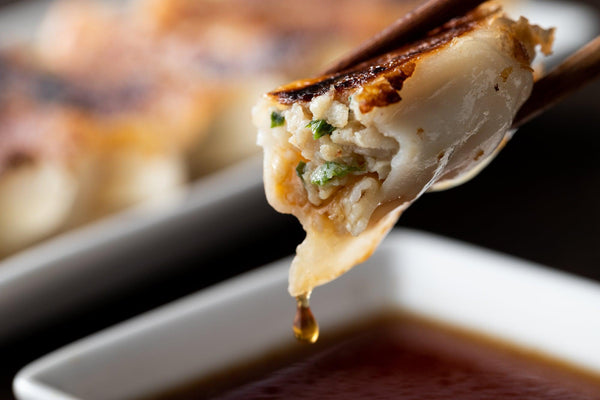5 Gyoza Recipes You Need To Make At Home This Week

Jump to:
What Is Gyoza?
Gyoza is a popular Japanese dumpling that can be found in tons of restaurants across Japan and even frozen in supermarkets. Did you know that gyoza can easily be made at home as well though? In this article, we’ll provide you with 5 gyoza recipes that you can make at home. We’ll also share tips and tricks along the way that will help you make perfect gyoza every single time!
Gyoza vs Potstickers?
Gyoza are Japanese dumplings, but how different are they from Chinese potstickers? They are actually quite similar to each other. Think of gyoza as the Japanese variation of potstickers. They tend to be smaller than potstickers and gyoza wrappers are also thinner than their Chinese counterparts. Since gyoza wrappers are thinner, they tend to get crispier as well.
Gyoza a delightful variation of the Chinese potsticker, typically featuring a thinner, more delicate wrapper. When learning how to cook dumplings like ajinomoto gyoza, you can pan-fry them until golden brown on one side, then steam them briefly to ensure the filling is fully cooked. Dumplings, in general, are versatile bites made by encasing fillings in dough, and gyoza is just one delicious example of what a dumpling can be, often served with a dipping sauce for added flavor.
Gyoza Ingredients

Before taking a trip to the grocery store to shop for gyoza ingredients, we’ll outline the most common ones below.
- Pork – pork is the go-to choice for making gyoza. It’s juicy due to its relatively high fat content giving gyoza plenty of savory flavor and juiciness. However, you can swap out ground pork for shrimp, chicken, tofu, etc. Just wait til we get to the recipes!
- Cabbage – Regular green cabbage is usually used when making gyoza whereas napa cabbage is more common for potstickers. You of course can also use napa cabbage when making gyoza as well though.
- Chinese Chives or Green Onions – Nira known as Chinese Chives or Garlic Chives in English is common in a lot of gyoza recipes. Green onions are popular as well. Both add a nice green color as well as flavor to the gyoza filling!
- Aromatics – Grated garlic and ginger are usually included in gyoza filling for flavor. You can use both or either, but it is definitely recommended NOT to skip out on them!
- Seasonings – sake, soy sauce, sesame oil, sugar, salt, and pepper will usually be included in most gyoza recipes. Some recipes may also include other seasonings like oyster sauce or even miso.
- Gyoza Wrappers – these are important for wrapping the gyoza of course. The Japanese ones are a bit smaller and thinner than the Chinese ones. These can be found in most grocery stores these days, but if you can’t find them, you can always try making them at home.
Once you’re comfortable with making gyoza, you can play around with the ingredients and create your own unique versions at home!
Tools For Making Gyoza
Shaping gyoza might seem a bit intimidating for some. While we do provide helpful tips and tricks for perfectly shaping at home, it’s still going to take some time to get the technique down for beginners. If you’re in a hurry, you can opt for this unique gyoza shaping kit instead. It’s also a perfect tool for your children to use if you want to turn making gyoza into a family activity.
You’ll also need a good pan for making super crispy, restaurant-quality gyoza at home. We recommend this iron pan for making gyoza because it has the right material, size, and shape for cooking gyoza and other ingredients that need strong fire. You can also use this teppanyaki turner for serving gyoza on plates.
Classic Gyoza

For beginners to gyoza or those looking for an introduction, why not start with our classic pork gyoza recipe? We take all of the common gyoza ingredients that we talked about before and turn them into a delectable dumpling. Once you make these, you’ll be coming back to this recipe over and over again!
Shrimp Gyoza

Looking to incorporate some seafood into your gyoza? Well, we’ve got the perfect recipe for you with our shrimp gyoza recipe. We mix shrimp with pork to provide the best of both worlds, but you can totally use only shrimp if you prefer. We love serving these gyoza with a spicy gyoza sauce of rice vinegar, soy sauce, and a little rayu chili oil.
Vegetable Gyoza

Would you believe us if we told you that vegetable gyoza is equally as delicious as its meat and seafood-containing counterparts? Using a combination of tofu (or soy meat mince), carrots, mushrooms, cabbage, with aromatics like ginger and garlic, and Japanese seasonings like miso, our vegan gyoza recipe is to die for. It’s a great way to sneak a little more veg into your diet too.
Chicken Gyoza

Our chicken gyoza recipe is probably the most stand-out recipe on this list. These gyoza are stick-shaped and use chunks of chicken as opposed to a ground meat-based mixture. We also use other common Japanese ingredients like shiso and umeboshi to give this recipe more of a Japanese flair. Finally, we finish the filling off with cheese because it actually works really well with these other ingredients.
Kimchi Gyoza Nabe

This is the perfect recipe to enjoy during the cold winter months. We combine gyoza and hotpot together in this recipe, using a kimchi-based soup base. This is a great recipe to make when you’re low on time but still want a hearty meal because you can use store bought gyoza!
Condiments That Pair Great With Gyoza
Now that you’ve discovered some of the best gyoza recipes on the internet, you’ll need some of the best Japanese condiments to go along with them. If you’re feeling too lazy to whip up your own gyoza sauce or you don’t have the ingredients, then this Mizkan Japanese Gyoza Dumpling Sauce is a perfect quick fix! You can also add chili oil, chopped chilis, or even chili vinegar to add extra spice. If you’d like a more citrusy option, then we recommend ponzu sauce or even yuzu kosho!
Looking for more Japanese recipe inspo? Be sure to check out our blog for more recipes.
Which gyoza recipe do you want to try first? We’d love to hear in the comments!

0 comments